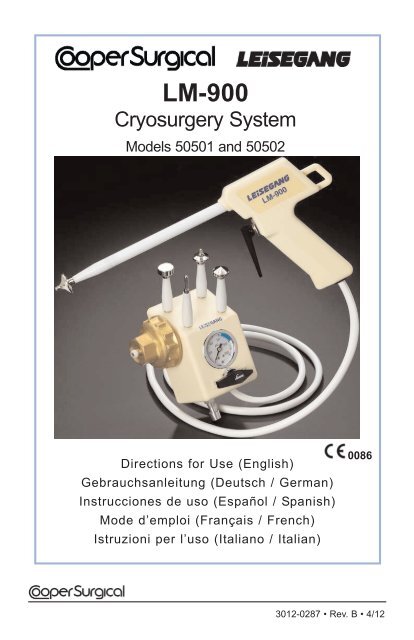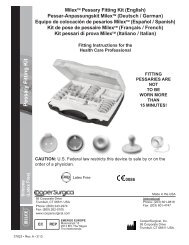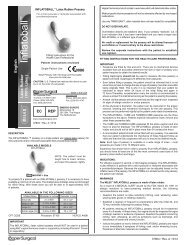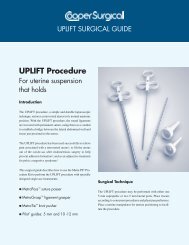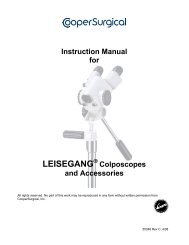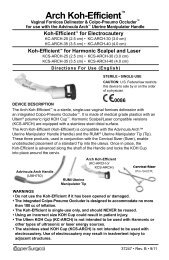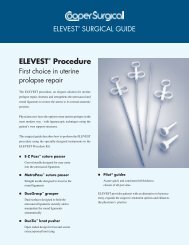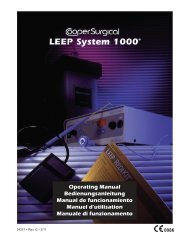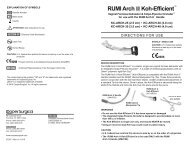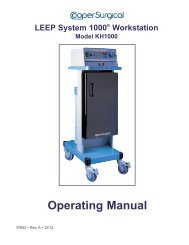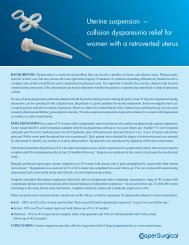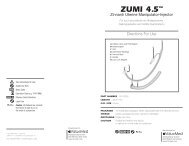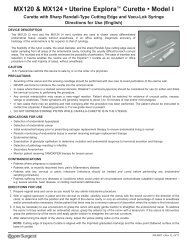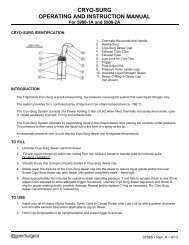LM-900 Cryosurgery System - CooperSurgical Inc.
LM-900 Cryosurgery System - CooperSurgical Inc.
LM-900 Cryosurgery System - CooperSurgical Inc.
You also want an ePaper? Increase the reach of your titles
YUMPU automatically turns print PDFs into web optimized ePapers that Google loves.
<strong>LM</strong>-<strong>900</strong><br />
<strong>Cryosurgery</strong> <strong>System</strong><br />
Models 50501 and 50502<br />
Directions for Use (English)<br />
Gebrauchsanleitung (Deutsch / German)<br />
Instrucciones de uso (Español / Spanish)<br />
Mode d’emploi (Français / French)<br />
Istruzioni per l’uso (Italiano / Italian)<br />
0086<br />
3012-0287 • Rev. B • 4/12
INTRODUCTION<br />
<strong>LM</strong>-<strong>900</strong> <strong>Cryosurgery</strong> <strong>System</strong><br />
Directions for Use (English)<br />
<strong>CooperSurgical</strong> is pleased you have chosen the <strong>LM</strong>-<strong>900</strong> <strong>Cryosurgery</strong> <strong>System</strong><br />
for use in your clinic or private practice.<br />
Model 50501 requires Medical Grade N2O (Nitrous Oxide) gas. Model 50502<br />
requires Medical Grade CO2 (Carbon Dioxide) gas.<br />
Each <strong>LM</strong>-<strong>900</strong> has been methodically handcrafted and tested prior to shipment.<br />
Proper care and maintenance should ensure a long and useful life.<br />
This Directions for Use document is intended to acquaint you with your new<br />
<strong>LM</strong>-<strong>900</strong> <strong>Cryosurgery</strong> <strong>System</strong>. It includes general and specific directions for use,<br />
and information on warnings and precautions, storage, cleaning, disinfection<br />
and sterilization.<br />
<strong>CooperSurgical</strong> always stands ready to assist you. Please feel free to contact<br />
our Customer Service department with any comments or questions.<br />
Send correspondence to:<br />
<strong>CooperSurgical</strong><br />
Customer Service Dept.<br />
95 Corporate Drive<br />
Trumbull, CT 06611 USA<br />
800-243-2974<br />
203-601-5200<br />
CLEANING PLUGS<br />
& “O” RINGS<br />
QUICK-CONNECT<br />
CARRYING CASE<br />
CONSOLE TIPS CRYOGUN<br />
MOBILE CART<br />
THE <strong>LM</strong>-<strong>900</strong> CRYOSURGERY SYSTEM<br />
The <strong>LM</strong>-<strong>900</strong> <strong>Cryosurgery</strong> <strong>System</strong> has been designed for easy assembly and<br />
operation. No tools are required.<br />
The <strong>LM</strong>-<strong>900</strong> is delivered in an attache carrying case along with interchangeable<br />
cryotips, a package of replacement “O” rings, cleaning plugs and a gas<br />
1<br />
20 POUND CYLINDER
scavenging hose. On the end of the cryogun barrel is a tip protector, which is<br />
removed when a cryotip is used, and replaced when the cryogun is not in use.<br />
An empty 20 lb N2O (Nitrous Oxide) or CO2 (Carbon Dioxide) gas cylinder is<br />
available for the <strong>LM</strong>-<strong>900</strong>. The N2O or CO2 gas is used as the refrigerant for the<br />
cryogenic process. The <strong>LM</strong>-<strong>900</strong> should be used only in a well-ventilated area.<br />
Consult your approved local compressed gas supplier. A twenty-foot (6.1 m)<br />
scavenging hose is provided to divert used gas away from the operator and<br />
patient. The mobile hand cart should be used for cylinder movement.<br />
Compressed gas cylinders should be refilled only by qualified suppliers. Do not<br />
allow the temperature where cylinders are stored to exceed normal room<br />
temperature.<br />
INDICATIONS<br />
The <strong>LM</strong>-<strong>900</strong> is a cryosurgery system intended to be used in the process of<br />
controlled destruction of defined areas of benign or pre-malignant lesions.<br />
CONTRAINDICATIONS<br />
The <strong>LM</strong>-<strong>900</strong> is not indicated for therapeutic treatments to the central circulatory or<br />
central nervous systems.<br />
CAUTION<br />
U.S. Federal law restricts this device to sale by or on the order of a licensed<br />
practitioner or licensed medical facility.<br />
WARNINGS<br />
Exposure to Nitrous Oxide may result in impairment of performance, cognition or<br />
dexterity. Ventilate well. Refer to instructions for venting Nitrous Oxide Gas.<br />
CLEANING<br />
<strong>LM</strong>-<strong>900</strong> <strong>Cryosurgery</strong> <strong>System</strong> • Directions for Use • English (continued)<br />
READ THIS ENTIRE DOCUMENT BEFORE OPERATING<br />
THE <strong>LM</strong>-<strong>900</strong> CRYOSURGERY INSTRUMENT<br />
WARNING: Do not use bleach or any product containing chloride in the cleaning<br />
of this product.<br />
CAUTION: Do not rinse or soak tips without first installing cleaning plugs. Make<br />
certain the cleaning plugs have rubber “O” rings in place to prevent liquid from<br />
entering the tips. Not using cleaning plugs will contribute to unit malfunction.<br />
The tips can be cleaned in mild soap and water solution with cleaning plugs<br />
installed and “O” rings in place. After cleaning, cleaning plugs should be removed<br />
and returned to the storage pouch. Cleaned tips can be stored on the metal studs<br />
located on the console.<br />
<strong>CooperSurgical</strong> recommends following the Centers for Disease Control (CDC)<br />
guidelines for disinfection and sterilization of non-immersible components by<br />
2
<strong>LM</strong>-<strong>900</strong> <strong>Cryosurgery</strong> <strong>System</strong> • Directions for Use • English (continued)<br />
“wrapping with a cloth soaked in a high-level disinfectant to allow the<br />
recommended contact time. After disinfection, the probe should be rinsed<br />
with tap water and dried before use” 1 .<br />
DISINFECTION<br />
WARNING: Cervical cryosurgical probes are recommended to have high-level<br />
disinfection between patients.<br />
The tips can be disinfected by soaking in a cold disinfectant with cleaning plugs<br />
installed and “O” rings in place. Clean tips before disinfecting. Follow CDC<br />
guidelines for disinfection 1 .<br />
Note: Limited well-designed studies available to base recommendations.<br />
STERILIZATION<br />
WARNING: Do not autoclave this instrument.<br />
CAUTION: All cleaning and sterilization should only be done with cleaning<br />
plugs and “O” rings in place on tips. Not using cleaning plugs will contribute<br />
to unit malfunction.<br />
COLD STERILIZATION<br />
The tips can be sterilized by soaking in a cold sterilant with cleaning plugs<br />
installed and “O” rings in place on tips. Follow the manufacturer’s guidelines<br />
for sterilization.<br />
STERRAD ® STERILIZATION<br />
Gas Plasma Processing (STERRAD <strong>System</strong>s) can be utilized to process<br />
instruments and medical devices when following manufacturer’s instructions.<br />
Sterrad methods have proven to be effective, low-temperature sterilization<br />
processes, while being gentler than steam conditioning. Proceed per the<br />
sterilizer manufacturer’s recommended procedure.<br />
EO STERILIZATION<br />
Thoroughly clean and dry cryo tips prior to EO sterilization.<br />
Follow the manufacturer’s instructions for operation and loading of sterilizer and<br />
utilize a valid EO cycle.<br />
RECOMMENDED HOSPITAL ETHYLENE OXIDE CYCLE<br />
Temperature . . . . . . . . . . . 125 °F - 130 °F (52 °C - 54 °C)<br />
50% RH (pre-humidity) . . . 60 minutes, -0/+10 minutes<br />
Pre Vacuum . . . . . . . . . . . 24 in. Hg ± 2 in. Hg (61 cm Hg ± 5 cm Hg)<br />
Gas Pressure . . . . . . . . . . 6 - 8 psig (550 - 660 mg/L)<br />
Exposure Time . . . . . . . . . 4 hours -0/+0.25 hours<br />
Post Vacuum . . . . . . . . . . 24 in. Hg 2X ± 2 in. Hg (61cm Hg 2X ± 5 cm Hg)<br />
Aeration . . . . . . . . . . . . . . 12 -0/+1 hours at 120 °F (49 °C)<br />
1 Guideline for Disinfection and Sterilization in Healthcare Facilities, CDC, 2008.<br />
3
<strong>LM</strong>-<strong>900</strong> <strong>Cryosurgery</strong> <strong>System</strong> • Directions for Use • English (continued)<br />
PRECAUTIONS<br />
• This device utilizes high pressure gas and must be used with care to avoid<br />
unexpected release of pressure. Maintenance and care must be taken to avoid<br />
injury to user and patient.<br />
• Use only medical grade gas under pressure range 600-800 psi (42-56 Kg/cm 2 )<br />
for optimal freeze.<br />
• Do not store gas cylinders above normal room temperature.<br />
• It is the operator’s responsibility to fit the exhaust hose between cryosurgical unit<br />
exhaust and disposal point to minimize gas exposure.<br />
• Do not drag, slide or roll cylinders. Cylinders should be stored upright and<br />
firmly secured to prevent falling or tipping.<br />
• Do not crimp or tightly bend the gas hose. The hose should be coiled no<br />
tighter than an 8 in. (20.3 cm) circle. A damaged hose must be replaced.<br />
• Do not use tools to tighten connections. Hand-tightening is all that is required.<br />
• Before disconnecting the console from the gas cylinder, turn gas cylinder valve OFF.<br />
• Before changing tips, make sure gas is off at the console.<br />
• If cryo tips are dropped, they should be returned to the factory for inspection.<br />
GENERAL INSTRUCTIONS<br />
Check the gas cylinder to be certain that it contains adequate gas. The pressure<br />
gauge should read between 600 and 800 psi (42-56 Kg/cm2 ) for proper freezing to<br />
occur. A pressure below 600 psi (42 Kg/cm2 ) may not provide enough pressure for<br />
sufficient freeze or defrost, and is not recommended. The gas cylinder should be<br />
securely seated on the mobile cart, and fastened with the provided safety chain.<br />
The tubing leading from the console to the cryogun should be examined by<br />
running the tube between the thumb and forefinger. Check for any kinks or abrupt<br />
bends. A kink in the line can cause a weakness, which can erupt under pressure.<br />
Located between the tip and the gun barrel is an “O” ring seal, which should be<br />
inspected prior to each use.<br />
Before each use, test for proper operation by following the instructions below,<br />
except point the tip towards the floor while squeezing the trigger for several<br />
seconds.<br />
SCAVENGING HOSE<br />
A twenty-foot (6.1 m) scavenging hose (P/N 3012-0314) is provided with the unit to<br />
divert gas away from the operator and patient to a remote, well-ventilated area.<br />
One end of the scavenging hose should be pushed over the exhaust muffler on<br />
the console of the cryo unit (mild soapy water will ease this operation), and the<br />
other end should lead to a remote, well-ventilated area.<br />
4
<strong>LM</strong>-<strong>900</strong> <strong>Cryosurgery</strong> <strong>System</strong> • Directions for Use • English (continued)<br />
VENTING NITROUS OXIDE GAS IN OPERATING ROOM, CLINIC OR OFFICE<br />
Exhaust gas for the <strong>LM</strong>-<strong>900</strong> system using nitrous oxide can be safely vented in a<br />
number of ways.<br />
1. Vented directly to the outside via the exhaust hose.<br />
2. Vented into room exhaust ventilation system provided the ventilation system<br />
is a non-recirculated type.<br />
3. Vented to a dedicated system for venting anesthetic gases. The flow capacity<br />
of the system shall have a capacity of no less than 40 L/min.<br />
CAUTION<br />
• Use ONLY the exhaust hose provided by <strong>CooperSurgical</strong>/ Leisegang. No<br />
substitutes allowed. Substitute parts may result in SEVERE RUPTURE OR<br />
BURSTING of the tubing and a subsequent loud noise.<br />
•. Do not restrict or kink any hose. Any restriction may expand the probe exhaust<br />
tubing to the point of rupture. (See Caution #1.)<br />
DIRECTIONS FOR USE<br />
1. Tighten quick-connect to medical grade gas supply.<br />
2. Connect gas scavenging hose to exhaust muffler on console. Vent to<br />
remote location.<br />
3. Select proper tip for cryosurgical procedure.<br />
4. Position tip tightly on cryogun, using finger pressure only.<br />
5. Open gas supply valve on cylinder.<br />
6. Turn arrow valve to ON position.<br />
7. Apply probe to surgical site.<br />
8. Squeeze trigger to freeze or push trigger forward to lock it in place during freeze<br />
mode. Note: Usual freeze time is 1 to 3 minutes.<br />
9. Release trigger to defrost.<br />
10. When procedure is complete, turn arrow valve to OFF position.<br />
11. Shut off gas supply valve.<br />
SERVICE<br />
The <strong>CooperSurgical</strong> Service Department is staffed with highly trained technicians<br />
whose primary responsibility is the safe and effective operation of your<br />
equipment.<br />
Please do not attempt to service the <strong>LM</strong>-<strong>900</strong> Cryosurgical <strong>System</strong> yourself. All<br />
service must be performed by <strong>CooperSurgical</strong>, <strong>Inc</strong>.<br />
Service department hours are between 8:30 AM and 5:00 PM, EST Monday<br />
through Friday.<br />
For assistance, please call 800-444-8456 or 203-601-5200.<br />
5
EXPLANATION OF SYMBOLS<br />
EC REP<br />
<strong>LM</strong>-<strong>900</strong> <strong>Cryosurgery</strong> <strong>System</strong> • Directions for Use • English (continued)<br />
0086<br />
Reorder Number<br />
Serial Number<br />
ATTENTION: See instructions for use.<br />
Authorized Representative in the European Community.<br />
Keep Dry<br />
Fragile<br />
CAUTION: U.S. Federal law restricts this device to sale by or on the<br />
order of a licensed practitioner or licensed medical facility.<br />
Product conforms to the Medical Device Directive 93/42/EEC.<br />
STERRAD ® is a registered trademark of Johnson & Johnson<br />
<strong>CooperSurgical</strong> is a registered trademark of <strong>CooperSurgical</strong>, <strong>Inc</strong>.<br />
© 2012 <strong>CooperSurgical</strong>, <strong>Inc</strong>.<br />
95 Corporate Drive<br />
Trumbull, CT 06611 USA<br />
Phone: (800) 243-2974<br />
Fax: (800) 262-0105<br />
www.coopersurgical.com<br />
International<br />
Phone: (203) 601-9818<br />
Fax: (203) 601-4747<br />
6<br />
Made in the USA<br />
EC REP<br />
Leisegang Feinmechanik GmbH<br />
Leibnizstraße 32<br />
D-10625, Berlin GERMANY<br />
3012-0287 • Rev. B • 4/12
EINLEITUNG<br />
Kryochirurgiesystem <strong>LM</strong>-<strong>900</strong><br />
Gebrauchsanleitung (Deutsch / German)<br />
<strong>CooperSurgical</strong> freut sich, dass Sie das Kryochirurgiesystem <strong>LM</strong>-<strong>900</strong> für den Einsatz<br />
in Ihrer Klinik oder Praxis gewählt haben.<br />
Modell 50501 benötigt medizinisches N2O-Gas (Lachgas). Modell 50502 benötigt<br />
medizinisches CO2-Gas (Kohlendioxid).<br />
Jedes <strong>LM</strong>-<strong>900</strong> wurde systematisch in Handarbeit hergestellt und vor der Auslieferung<br />
getestet. Sachgemäße Pflege und Wartung sollten eine lange Nutzungsdauer<br />
gewährleisten.<br />
Diese Gebrauchsanleitung soll Sie mit Ihrem neuen Kryochirurgiesystem <strong>LM</strong>-<strong>900</strong><br />
vertraut machen. Sie umfasst allgemeine und spezifische Anweisungen für den<br />
Einsatz, und Informationen über Warnhinweise und Vorsichtsmaßnahmen, Lagerung,<br />
Reinigung, Desinfektion und Sterilisation.<br />
<strong>CooperSurgical</strong> ist immer bereit, Sie zu unterstützen. Bitte zögern Sie nicht, unseren<br />
Kundendienst wegen Anmerkungen oder Fragen zu kontaktieren.<br />
Briefe bitte an folgende Adresse schicken:<br />
<strong>CooperSurgical</strong><br />
Customer Service Dept. (Abt. Kundendienst)<br />
95 Corporate Drive<br />
Trumbull, CT 06611 USA<br />
+1-800-243-2974<br />
+1-203-601-5200<br />
REINIGUNGSSTECKER<br />
UND O-RINGE<br />
SCHNELLANSCHLUSS<br />
TRANSPORTKOFFER<br />
MOBILER WAGEN<br />
KONSOLE<br />
SPITZEN<br />
KRYOPISTOLE<br />
9,1-KG-(20 LB) ZYLINDER<br />
DAS KRYOCHIRURGIESYSTEM <strong>LM</strong>-<strong>900</strong><br />
Das Kryochirurgiesystem <strong>LM</strong>-<strong>900</strong> ist für eine einfache Montage und Bedienung<br />
ausgelegt. Es sind keine Werkzeuge erforderlich.<br />
7
Kryochirurgiesystem <strong>LM</strong>-<strong>900</strong> • Gebrauchsanleitung • Deutsch / German (Fortsetzung)<br />
Das <strong>LM</strong>-<strong>900</strong> wird in einem Attachetransportkoffer zusammen mit austauschbaren<br />
Kryospitzen, einem Paket Ersatz-O-Ringen, Reinigungssteckern und einem<br />
Gasabfangschlauch geliefert. Am Ende des Kryopistolenlaufs befindet sich ein<br />
Spitzenschutz, der entfernt wird, wenn eine Kryospitze verwendet wird, und wieder<br />
aufgesetzt wird, sobald die Kryopistole nicht in Gebrauch ist.<br />
Für das <strong>LM</strong>-<strong>900</strong> ist ein leerer Gaszylinder für 9,1 kg (20 lb) N2O (Lachgas) oder CO2 (Kohlendioxid) erhältlich. Das N2O- oder CO2-Gas wird als Kältemittel für die<br />
Kryoeingriffe verwendet. Das <strong>LM</strong>-<strong>900</strong> sollte nur in einem gut belüfteten Raum<br />
eingesetzt werden. Fragen Sie Ihren örtlich zugelassenen Druckgaslieferanten.<br />
Ein 6,1 m (20 ft.) langer Abfangschlauch wird zur Verfügung gestellt, um das Gas von<br />
Bediener und Patient wegzulenken. Der mobile Handwagen sollte für den Transport<br />
des Zylinders eingesetzt werden. Druckgaszylinder sollten ausschließlich von<br />
qualifizierten Lieferanten befüllt werden. Lassen Sie die Temperatur dort, wo der<br />
Zylinder gelagert wird, nicht über normale Raumtemperatur ansteigen.<br />
LESEN SIE DAS GESAMTE DOKUMENT, BEVOR SIE DAS<br />
KRYOCHIRURGIESYSTEM <strong>LM</strong>-<strong>900</strong> EINSETZEN<br />
INDIKATIONEN<br />
Das <strong>LM</strong>-<strong>900</strong> ist ein Kryochirurgiesystem, das für den Prozess der kontrollierten<br />
Zerstörung definierter Bereiche benigner oder maligner Läsionen eingesetzt wird.<br />
KONTRAINDIKATIONEN<br />
Das <strong>LM</strong>-<strong>900</strong> ist nicht für therapeutische Behandlungen des Zentralkreislaufsystems<br />
oder Zentralnervensystems indiziert.<br />
VORSICHT<br />
Nach US-amerikanischem Bundesgesetz darf dieses Gerät nur durch oder auf<br />
Anordnung eines zugelassenen Arztes oder einer medizinischen Einrichtung<br />
gekauft werden.<br />
WARNHINWEISE<br />
Die Exposition gegenüber Lachgas kann zu einer Beeinträchtigung der Leistung,<br />
Kognition oder Geschicklichkeit führen. Entlüften Sie gut. Siehe Anleitung zum<br />
Entlüften von Lachgas.<br />
REINIGUNG<br />
WARNHINWEIS: Verwenden Sie keine Bleichmittel oder chlorhaltigen Produkte zur<br />
Reinigung dieses Produkts.<br />
VORSICHT: Die Spitzen nicht ohne vorherige Installation der Reinigungsstecker<br />
ausspülen oder einweichen. Stellen Sie sicher, dass die Reinigungsstecker mit<br />
Kunststoff-O-Ringen ausgestattet sind, um Flüssigkeit in den Spitzen zu vermeiden.<br />
Bei Nicht-Verwendung von Reinigungssteckern kann es zu einer Fehlfunktion<br />
des Gerätes kommen.<br />
Die Spitzen können mit angebrachten Reinigungssteckern und O-Ringen in einer<br />
milden wässrigen Seifenlösung gereinigt werden. Nach der Reinigung sollten die<br />
8
Kryochirurgiesystem <strong>LM</strong>-<strong>900</strong> • Gebrauchsanleitung • Deutsch / German (Fortsetzung)<br />
Reinigungsstecker entfernt und in die Aufbewahrungstasche zurückgelegt werden.<br />
Gereinigte Spitzen können auf den Metallnoppen auf der Konsole gelagert werden.<br />
<strong>CooperSurgical</strong> empfiehlt die folgenden Richtlinien der Centers for Disease Control<br />
(CDC) zur Desinfektion und Sterilisation von nicht tauchbaren Komponenten durch<br />
„Einwickeln in einem mit einem Desinfektionsmittel für höchste Ansprüche<br />
getränkten Tuch, um die empfohlene Kontaktzeit zu gewährleisten. Nach der<br />
Desinfektion ist die Sonde vor dem Gebrauch mit Leitungswasser abzuspülen<br />
und abzutrocknen“ 1 .<br />
DESINFEKTION<br />
WARNHINWEIS: Es wird empfohlen, kryochirurgische Zervixsonden zwischen<br />
Patienten einer High-Level-Desinfektion zu unterziehen.<br />
Die Spitzen können mit angebrachten Reinigungssteckern und O-Ringen durch<br />
Einweichen in kaltem Desinfektionsmittel desinfiziert werden. Reinigen Sie die Spitzen<br />
vor der Desinfektion. Befolgen Sie die CDC-Desinfektionsrichtlinien 1 .<br />
Hinweis: Als Grundlage für die Empfehlungen liegt eine begrenzte Zahl von Studien<br />
mit gutem Studiendesign vor.<br />
STERILISATION<br />
WARNHINWEIS: Dieses Instrument nicht autoklavieren.<br />
VORSICHT: Alle Reinigungs- und Sterilisationsverfahren sollten nur mit den<br />
Reinigungssteckern und den auf den Spitzen angebrachten O-Ringen erfolgen. Bei<br />
Nicht-Verwendung von Reinigungssteckern kann es zu einer Fehlfunktion des<br />
Gerätes kommen.<br />
KALTSTERILISATION<br />
Die Spitzen können mit angebrachten Reinigungssteckern und den an den Spitzen<br />
angebrachten O-Ringen durch Einweichen in kaltem Desinfektionsmittel desinfiziert<br />
werden. Befolgen Sie zur Desinfektion die Richtlinien des Herstellers.<br />
STERRAD ® -STERILISATION<br />
Gasplasmabearbeitung (STERRAD-<strong>System</strong>e) kann genutzt werden, um Instrumente<br />
und medizinische Geräte aufzubereiten, wenn die Anweisungen des Herstellers<br />
befolgt werden. Sterrad-Methoden haben sich als wirksame Niedertemperatur-<br />
Sterilisationsverfahren erwiesen, wobei sie schonender als eine Behandlung mit<br />
Dampf sind. Gehen Sie nach dem vom Sterilisator-Hersteller empfohlenen Verfahren<br />
vor.<br />
STERILISATION MIT ETHYLENOXID<br />
Reinigen und trocknen Sie die Kryospitzen vor der EO-Sterilisation gründlich.<br />
Folgen Sie den Anweisungen des Herstellers für den Betrieb und das Laden des<br />
Sterilisators und verwenden Sie einen geeigneten EO-Zyklus.<br />
EMPFOHLENER KRANKENHAUS-ETHYLENOXIDZYKLUS<br />
Temperatur . . . . . . . . . . . . . . . . . . 52 °C - 54 °C (125 °F - 130 °F)<br />
50 % rF (Vorluftfeuchtigkeit) . . . . . 60 Minuten -0/+10 Minuten<br />
1 Guideline for Disinfection and Sterilization in Healthcare Facilities, CDC, 2008 [Richtlinie<br />
zur Desinfektion und Sterilisation in Gesundheitseinrichtungen.]<br />
9
Kryochirurgiesystem <strong>LM</strong>-<strong>900</strong> • Gebrauchsanleitung • Deutsch / German (Fortsetzung)<br />
Vorvakuum . . . . . . . . . . . . . . . . . . 61 cm Hg ± 5 cm Hg (24 in. Hg ± 2 in. Hg)<br />
Gasdruck . . . . . . . . . . . . . . . . . . . . 550 - 660 mg/l (6 - 8 psig)<br />
Expositionszeit . . . . . . . . . . . . . . . 4 Stunden -0/+0,25 Stunden<br />
Postvakuum . . . . . . . . . . . . . . . . . 61 cm Hg 2x ± 5 cm Hg (24 in. Hg 2 x ± 2 in. Hg)<br />
Belüftung . . . . . . . . . . . . . . . . . . . . 12 -0/+1 Stunden bei 49 °C (120 °F)<br />
VORSICHTSMAßNAHMEN<br />
• Dieses Gerät verwendet Hochdruckgas und muss mit Vorsicht benutzt werden, um<br />
eine unerwartete Druckfreisetzung zu vermeiden. Wartung und Pflege müssen<br />
beachtet werden, um Verletzungen bei Anwender und Patient zu vermeiden.<br />
• Benutzen Sie für ein optimales Einfrieren ausschließlich medizinisches Gas im<br />
Druckbereich von 42-56 Kg/cm 2 (600-800 psi).<br />
• Lagern Sie Gaszylinder nicht über Raumtemperatur.<br />
• Es liegt in der Verantwortung des Bedieners, den Abgasschlauch zwischen der<br />
kryochirurgischen Einheit und der Abgasentsorgungsstelle so anzubringen, dass<br />
eine Gasexposition minimiert wird.<br />
• Zylinder nicht ziehen, schieben oder rollen. Die Zylinder sollten aufrecht gelagert<br />
werden und gesichert sein, um ein Umfallen zu verhindern.<br />
• Den Gasschlauch nicht quetschen oder knicken. Der Schlauch sollte nicht enger<br />
als in einem 20,3 cm (8 in.) weiten Kreis aufgerollt werden. Ein beschädigter<br />
Schlauch muss ersetzt werden.<br />
• Verwenden Sie keine Werkzeuge, um Anschlüsse festzuziehen. Es ist lediglich ein<br />
Anziehen mit der Hand erforderlich.<br />
• Vor dem Trennen der Gasflasche von der Konsole stellen Sie das Gaszylinderventil<br />
auf OFF.<br />
• Stellen Sie vor dem Auswechseln der Spitzen sicher, dass das Gas an der Konsole<br />
abgeschaltet ist.<br />
• Wenn Kryospitzen fallen gelassen wurden, sollten sie zur Überprüfung an die<br />
Fabrik zurückgeschickt werden.<br />
ALLGEMEINE ANLEITUNGEN<br />
Überprüfen Sie den Gaszylinder, um sicher zu gehen, dass er ausreichend Gas<br />
enthält. Das Manometer sollte für ein ordnungsgemäßes Einfrieren zwischen 42-56<br />
kg/cm2 (600 und 800 psi) anzeigen. Ein Druck unter 42 kg/cm2 (600 psi) kann<br />
möglicherweise nicht genug Druck für ein ausreichendes Einfrieren oder Auftauen<br />
bieten, und wird nicht empfohlen. Der Gaszylinder sollte sicher auf dem mobilen<br />
Wagen stehen und mit der mitgelieferten Sicherheitskette befestigt werden.<br />
Untersuchen Sie den Schlauch, der von der Kryopistole zur Konsole führt, indem Sie<br />
mit Daumen und Zeigefinger am Schlauch entlangfahren. Prüfen Sie auf Knicke oder<br />
abrupte Kurven. Ein Knick in der Leitung kann eine Schwachstelle verursachen, die<br />
unter Druck aufbrechen kann.<br />
Zwischen der Spitze und dem Pistolenlauf befindet sich eine O-Ringdichtung, die vor<br />
jedem Einsatz überprüft werden sollte.<br />
10
Kryochirurgiesystem <strong>LM</strong>-<strong>900</strong> • Gebrauchsanleitung • Deutsch / German (Fortsetzung)<br />
Testen Sie vor jedem Einsatz auf einen ordnungsgemäßen Betrieb, indem Sie die<br />
unten stehenden Anweisungen befolgen, mit der Ausnahme, dass Sie beim Drücken<br />
des Auslösers für einige Sekunden die Spitze in Richtung Boden halten.<br />
ABFANGSCHLAUCH<br />
Ein 6,1 m (20 ft.) langer Abfangschlauch (Art.-Nr. 3012-0314) wird mit dem Gerät<br />
geliefert, um das Gas vom Bediener und Patienten weg zu einem abgelegenen, gut<br />
belüfteten Bereich umzuleiten. Ein Ende des Abfangschlauchs sollte über den<br />
Abgasschalldämpfer auf der Konsole der Kryoeinheit geschoben werden (eine milde<br />
Seifenlauge vereinfacht die Handhabung), und das andere Ende sollte zu einem<br />
entfernten, gut belüfteten Bereich führen.<br />
ENTLÜFTUNG VON LACHGAS IN OP, KLINIK ODER PRAXIS<br />
Abgas des <strong>LM</strong>-<strong>900</strong>-<strong>System</strong>s, das Lachgas einsetzt, kann auf verschiedene Arten<br />
sicher entlüftet werden.<br />
1. Entlüftung über den Abgasschlauch direkt nach außen.<br />
2. Entlüftung in die Raumabsauganlage, sofern die Lüftungsanlage keine wieder in<br />
den Kreislauf einspeisende Anlage ist.<br />
3. Entlüftung in ein spezielles <strong>System</strong> zum Entlüften von Narkosegasen. Die<br />
Durchflusskapazität des <strong>System</strong>s sollte eine Kapazität von nicht weniger als<br />
40 l/min haben.<br />
VORSICHT<br />
• Verwenden Sie AUSSCHLIESSLICH den durch <strong>CooperSurgical</strong>/Leisegang<br />
bereitgestellten Abgasschlauch. Keine Ersatzmaterialien gestattet. Ersatzteile<br />
können zu einem GROSSEN RISS ODER PLATZEN der Schläuche gefolgt von<br />
einem lauten Knall führen.<br />
•. Schränken Sie den Schlauch nicht ein und knicken Sie ihn nicht. Jede Blockade<br />
kann die Sondenabgasleitung erweitern, bis ein Riss auftritt. (Siehe Warnhinweis 1.)<br />
GEBRAUCHSANWEISUNG<br />
1. Ziehen Sie den Schnellanschluss zur medizinischen Gaszufuhr fest.<br />
2. Schließen Sie den Abfangschlauch an den Abgasschalldämpfer auf der Konsole<br />
an. Entlüften Sie an einen entfernten Standort.<br />
3. Wählen Sie die korrekte Spitze für das kryochirurgische Verfahren aus.<br />
4. Platzieren Sie nur mit Fingerdruck die Spitze fest auf der Kryopistole.<br />
5. Öffnen Sie das Gaszufuhrventil am Zylinder.<br />
6. Stellen Sie den Pfeil des Ventils auf ON.<br />
7. Setzen Sie die Sonde auf die Operationsstelle.<br />
8. Drücken Sie den Auslöser zum Einfrieren herunter oder schieben Sie den Auslöser<br />
nach vorne, um ihn während des Einfriermodus zu arretieren. Hinweis: Die<br />
übliche Einfrierzeit beträgt 1 bis 3 Minuten.<br />
9. Lassen Sie den Auslöser zum Auftauen los.<br />
10. Wenn der Eingriff abgeschlossen ist, stellen Sie den Ventilpfeil in die Position OFF.<br />
11. Schließen Sie das Gaszufuhrventil.<br />
11
Kryochirurgiesystem <strong>LM</strong>-<strong>900</strong> • Gebrauchsanleitung • Deutsch / German (Fortsetzung)<br />
KUNDENDIENST<br />
Die Kundendienstabteilung von <strong>CooperSurgical</strong> ist mit hoch qualifizierten Technikern<br />
besetzt, deren primäre Aufgabe der sichere und effektive Betrieb Ihrer Ausrüstung ist.<br />
Bitte versuchen Sie nicht, das Kryochirurgiesystem <strong>LM</strong>-<strong>900</strong> selbst zu reparieren. Alle<br />
Wartungsarbeiten müssen von <strong>CooperSurgical</strong>, <strong>Inc</strong>. durchgeführt werden.<br />
Die Arbeitszeit der Kundendienstabteilung ist von Montag bis Freitag, 8.30 Uhr bis<br />
17.00 Uhr EST.<br />
Für Unterstützung nehmen Sie bitte telefonisch Kontakt auf unter +1-800-444-8456<br />
oder +1-203-601-5200.<br />
SYMBOLE<br />
EC REP<br />
0086<br />
Nachbestellnummer<br />
Seriennummer<br />
ACHTUNG: Siehe Gebrauchsanleitung.<br />
Autorisierte Vertretung in der Europäischen Gemeinschaft.<br />
Trocken halten<br />
Zerbrechlich<br />
VORSICHT: Nach US-amerikanischem Bundesgesetz darf dieses Gerät<br />
nur durch oder auf Anordnung eines zugelassenen Arztes oder einer<br />
medizinischen Einrichtung gekauft werden.<br />
Produkt entspricht der Medizinprodukterichtlinie 93/42/EEG.<br />
STERRAD ® ist eine eingetragene Marke von Johnson & Johnson<br />
<strong>CooperSurgical</strong> ist eine eingetragene Marke von <strong>CooperSurgical</strong>, <strong>Inc</strong>.<br />
© 2012 <strong>CooperSurgical</strong>, <strong>Inc</strong>.<br />
95 Corporate Drive<br />
Trumbull, CT 06611 USA<br />
Tel: +1 (800) 243-2974<br />
Fax: +1 (800) 262-0105<br />
www.coopersurgical.com<br />
International<br />
Tel: +1 (203) 601-9818<br />
Fax: +1 (203) 601-4747<br />
12<br />
Hergestellt in USA<br />
EC REP<br />
Leisegang Feinmechanik GmbH<br />
Leibnizstraße 32<br />
D-10625, Berlin GERMANY<br />
3012-0287 • Rev. B • 4/12
INTRODUCCIÓN<br />
Sistema de criocirugía <strong>LM</strong>-<strong>900</strong><br />
Instrucciones de uso (Español / Spanish)<br />
<strong>CooperSurgical</strong> se complace de que haya elegido el Sistema de criocirugía <strong>LM</strong>-<strong>900</strong><br />
para utilizarlo en su clínica o consulta privada.<br />
El modelo 50501 utiliza gas N2O (óxido nitroso) de grado médico. El modelo 50502<br />
utiliza gas CO2 (dióxido de carbono) de grado médico.<br />
Todos los dispositivos <strong>LM</strong>-<strong>900</strong> se fabrican a mano meticulosamente y se prueban<br />
antes de su envío. Un cuidado y un mantenimiento adecuados garantizarán una vida<br />
útil prolongada.<br />
Estas instrucciones de uso le permitirán familiarizarse con el nuevo Sistema de<br />
criocirugía <strong>LM</strong>-<strong>900</strong>. Se incluyen instrucciones de uso generales y específicas, así<br />
como información sobre advertencias y precauciones, almacenamiento, limpieza,<br />
desinfección y esterilización.<br />
<strong>CooperSurgical</strong> siempre está dispuesto a prestarle asistencia. Póngase en contacto<br />
con nuestro departamento de atención al cliente si tiene algún comentario o pregunta.<br />
Envíe la correspondencia a:<br />
<strong>CooperSurgical</strong><br />
Customer Service Dept.<br />
95 Corporate Drive<br />
Trumbull, CT 06611 USA<br />
+1-800-243-2974<br />
+1-203-601-5200<br />
TAPONES DE LIMPIEZA Y<br />
JUNTAS TÓRICAS<br />
CONECTOR RÁPIDO<br />
CONSOLA<br />
PUNTAS<br />
MALETÍN DE<br />
TRANSPORTE<br />
CARRITO MÓVIL<br />
PISTOLA DE<br />
CRIOCIRUGÍA<br />
BOMBONA DE 9 KG (20 LBS.)<br />
SISTEMA DE CRIOCIRUGÍA <strong>LM</strong>-<strong>900</strong><br />
El Sistema de criocirugía <strong>LM</strong>-<strong>900</strong> se ha diseñado para facilitar su montaje y manejo.<br />
No se necesitan herramientas.<br />
13
Sistema de criocirugía <strong>LM</strong>-<strong>900</strong> • Instrucciones de uso • Español / Spanish (continuación)<br />
El <strong>LM</strong>-<strong>900</strong> se envía en un maletín de transporte junto con puntas de criocirugía<br />
intercambiables, un paquete de juntas tóricas de repuesto, tapones de limpieza y una<br />
manguera de recuperación de gases. En el extremo del cañón de la pistola de<br />
criocirugía hay un protector de puntas, el cual se retira al utilizar una punta y se<br />
vuelve a colocar una vez concluido el uso de la pistola.<br />
Hay disponibles bombonas de gas vacías de 9 kg (20 lbs.) de N2O (óxido nitroso) o<br />
CO2 (dióxido de carbono) para el <strong>LM</strong>-<strong>900</strong>. El gas N2O o CO2 se utiliza como<br />
refrigerante durante el proceso criogénico. El <strong>LM</strong>-<strong>900</strong> debe utilizarse únicamente en<br />
zonas bien ventiladas. Consulte con su proveedor local autorizado de gas<br />
comprimido. Se proporciona una manguera de recuperación de gases de 6,1 m (20<br />
pies) para derivar el gas usado lejos del operario y el paciente. Para mover la<br />
bombona se utiliza el carrito de mano móvil. Únicamente proveedores certificados<br />
deben rellenar las bombonas de gas comprimido. No permita que la temperatura del<br />
lugar de almacenamiento de las bombonas sobrepase la temperatura ambiente<br />
normal.<br />
LEA COMPLETAMENTE ESTE DOCUMENTO ANTES DE MANIPULAR<br />
EL INSTRUMENTO DE CRIOCIRUGÍA <strong>LM</strong>-<strong>900</strong><br />
INDICACIONES<br />
El <strong>LM</strong>-<strong>900</strong> es un sistema de criocirugía diseñado para la destrucción controlada de<br />
zonas definidas con lesiones benignas o precancerosas.<br />
CONTRAINDICACIONES<br />
El <strong>LM</strong>-<strong>900</strong> no está indicado para tratamientos terapéuticos en los sistemas circulatorio<br />
central o nervioso central.<br />
PRECAUCIÓN<br />
Las leyes federales norteamericanas solo permiten la venta de este dispositivo a<br />
médicos colegiados o instituciones médicas oficiales.<br />
ADVERTENCIAS<br />
La exposición al óxido nitroso puede provocar un deterioro del desempeño, la<br />
cognición o la destreza. Ventile adecuadamente. Consulte las instrucciones de<br />
ventilación del óxido nitroso.<br />
LIMPIEZA<br />
ADVERTENCIA: no utilice lejía ni ningún otro producto que contenga cloruro para la<br />
limpieza de este producto.<br />
PRECAUCIÓN: no enjuague ni empape las puntas sin instalar antes los tapones de<br />
limpieza. Asegúrese de que los tapones de limpieza tienen colocadas las juntas<br />
tóricas de goma para evitar que el líquido entre en las puntas. Si no se utilizan los<br />
tapones de limpieza, la unidad puede dejar de funcionar correctamente.<br />
Las puntas se pueden limpiar con una solución de agua y jabón suave, siempre que<br />
tengan colocados los tapones de limpieza con las juntas tóricas correspondientes.<br />
Después de la limpieza, los tapones deben retirarse y colocarse de nuevo en la bolsa<br />
14
Sistema de criocirugía <strong>LM</strong>-<strong>900</strong> • Instrucciones de uso • Español / Spanish (continuación)<br />
de almacenamiento. Las puntas limpias se pueden guardar en las clavijas metálicas<br />
de la consola.<br />
<strong>CooperSurgical</strong> recomienda seguir las directrices de los Centros de control de<br />
enfermedades (CDC) para la desinfección y esterilización de componentes no<br />
sumergibles, “envolviéndolos con un trapo empapado en un desinfectante de alta<br />
gama para garantizar el tiempo de contacto recomendado. Tras la desinfección,<br />
la sonda debe enjuagarse con agua del grifo y secarse antes de su utilización” 1 .<br />
DESINFECCIÓN<br />
ADVERTENCIA: se recomienda desinfectar a fondo las sondas para criocirugía<br />
cervical antes de usarlas en un nuevo paciente.<br />
Las puntas se pueden desinfectar sumergiéndolas en un desinfectante en frío,<br />
siempre con los tapones de limpieza y las juntas tóricas colocados en su sitio. Limpie<br />
las puntas antes de desinfectarlas. Siga las directrices de los CDC para la<br />
desinfección 1 .<br />
Nota: hay disponibles estudios limitados y bien diseñados para fundamentar<br />
las recomendaciones.<br />
ESTERILIZACIÓN<br />
ADVERTENCIA: no coloque este instrumento en un autoclave.<br />
PRECAUCIÓN: cualquier limpieza y esterilización debe realizarse únicamente con los<br />
tapones de limpieza y las juntas tóricas colocados sobre las puntas. Si no se utilizan<br />
los tapones de limpieza, la unidad puede dejar de funcionar correctamente.<br />
ESTERILIZACIÓN EN FRÍO<br />
Las puntas se pueden esterilizar sumergiéndolas en un esterilizante en frío, siempre<br />
con los tapones de limpieza y las juntas tóricas colocados sobre las puntas. Siga las<br />
directrices del fabricante sobre la esterilización.<br />
ESTERILIZACIÓN STERRAD ®<br />
Se puede utilizar el procesado por plasma de gas (sistemas STERRAD) para procesar<br />
instrumentos y dispositivos médicos, siempre que se sigan las instrucciones del<br />
fabricante. Los métodos Sterrad han demostrado ser procesos eficaces de<br />
esterilización a baja temperatura, siendo menos agresivos que la esterilización<br />
mediante vapor. Utilice el procedimiento recomendado por el fabricante del<br />
esterilizador.<br />
ESTERILIZACIÓN CON ÓXIDO DE ETILENO<br />
Limpie y seque a fondo las puntas de criocirugía antes de esterilizarlas con óxido<br />
de etileno.<br />
Siga las instrucciones del fabricante para manejar y cargar el esterilizador y utilice un<br />
ciclo de óxido de etileno válido.<br />
CICLO RECOMENDADO DE ÓXIDO DE ETILENO EN HOSPITAL<br />
Temperatura . . . . . . . . . . . . . . . . . 52 °C - 54 °C (125 °F - 130 °F)<br />
50% de humedad relativa<br />
(prehumedad) . . . . . . . . . . . . . . . . 60 minutos, -0/+10 minutos<br />
1 Guideline for Disinfection and Sterilization in Healthcare Facilities (directrices para la<br />
desinfección y esterilización de instalaciones médicas), CDC, 2008.<br />
15
Sistema de criocirugía <strong>LM</strong>-<strong>900</strong> • Instrucciones de uso • Español / Spanish (continuación)<br />
Prevacío . . . . . . . . . . . . . . . . . . . . 61 cm Hg ± 5 cm Hg (24 in. Hg ± 2 in. Hg)<br />
Presión del gas . . . . . . . . . . . . . . . 550 - 660 mg/l (6 - 8 psig)<br />
Tiempo de exposición . . . . . . . . . . 4 horas -0/+0,25 horas<br />
Vacío posterior . . . . . . . . . . . . . . . 61 cm Hg 2X ± 5 cm Hg (24 in. Hg 2X ± 2 in. Hg)<br />
Aireación . . . . . . . . . . . . . . . . . . . . 12 -0/+1 horas a 49 °C (120 °F)<br />
PRECAUCIONES<br />
• Este dispositivo utiliza gas sometido a alta presión y debe utilizarse con cuidado<br />
para evitar escapes de presión inesperados. Se debe llevar a cabo el<br />
mantenimiento y proceder con cuidado para evitar lesiones al usuario y<br />
al paciente.<br />
• Utilice únicamente gas de grado médico en un intervalo de presión de 42-56<br />
kg/cm 2 (600-800 psi) para una congelación óptima.<br />
• No almacene las bombonas de gas en un lugar con una temperatura ambiente<br />
más alta de lo normal.<br />
• El operario es responsable de ajustar la manguera de escape entre la salida de la<br />
unidad de criocirugía y el punto de eliminación para reducir al mínimo la<br />
exposición al gas.<br />
• No arrastre, deslice ni haga rodar las bombonas. Las bombonas deben guardarse<br />
de pie y firmemente sujetas para evitar que se caigan o se vuelquen.<br />
• No rice ni flexione fuertemente la manguera del gas. La manguera no debe<br />
enrollarse formando un círculo menor de 20,3 cm (8 in.). Si la manguera está<br />
dañada, debe reemplazarse.<br />
• No utilice herramientas para apretar las conexiones. Apriételas únicamente a mano.<br />
• Antes de desconectar la consola de la bombona de gas, coloque la válvula de la<br />
bombona en OFF (cerrado).<br />
• Antes de cambiar las puntas, asegúrese de que el gas esté desactivado en la consola.<br />
• Si las puntas de criocirugía se caen, debe devolverlas a la fábrica para su inspección.<br />
INSTRUCCIONES GENERALES<br />
Compruebe la bombona para asegurarse de que contiene el gas adecuado. El<br />
indicador de presión debe estar entre 42 y 56 kg/cm2 (600 y 800 psi) para obtener una<br />
congelación óptima. Una presión por debajo de 42 kg/cm2 (600 psi) puede que no<br />
proporcione la presión suficiente para congelar o descongelar, por lo que no se<br />
recomienda. La bombona de gas debe estar bien asentada en el carrito móvil y sujeta<br />
con la cadena de seguridad proporcionada.<br />
El tubo que va desde la consola a la pistola de criocirugía debe examinarse<br />
recorriéndolo con el pulgar y el índice. Inspecciónelo en busca de alguna arruga o<br />
flexión brusca. Una arruga podría provocar que se debilitara, lo que podría hacer que<br />
estallara con la presión.<br />
Entre la punta y el cañón de la pistola se encuentra una junta tórica, la cual debe<br />
inspeccionarse antes de cada uso.<br />
Antes de cada uso, compruebe el funcionamiento correcto de acuerdo con las<br />
instrucciones siguientes, salvo la instrucción de poner la punta hacia el suelo mientras<br />
aprieta el gatillo durante varios segundos.<br />
16
Sistema de criocirugía <strong>LM</strong>-<strong>900</strong> • Instrucciones de uso • Español / Spanish (continuación)<br />
MANGUERA DE RECUPERACIÓN<br />
Junto con la unidad se proporciona una manguera de recuperación de gases (n.º de<br />
pieza 3012-0314) de 6,1 m (20 ft.), para derivar el gas usado lejos del operario y del<br />
paciente hacia una zona alejada y bien ventilada. Un extremo de la manguera se<br />
debe colocar en el silenciador de salida de la consola de la unidad de criocirugía<br />
(una solución de agua jabonosa facilitará esta operación); el otro extremo debe ir a<br />
una zona alejada y bien ventilada.<br />
VENTILACIÓN DEL ÓXIDO NITROSO EN LA SALA DE OPERACIONES,<br />
CLÍNICA O CONSULTA<br />
El gas de escape de los sistemas <strong>LM</strong>-<strong>900</strong> que utilizan óxido nitroso se puede ventilar<br />
de forma segura de varias maneras.<br />
1. Directamente al exterior a través de la manguera de escape.<br />
2. Al sistema de ventilación de la sala, si se trata de un sistema de ventilación<br />
sin recirculación.<br />
3. A un sistema específico para la ventilación de gases anestésicos. La capacidad de<br />
flujo del sistema debe ser mayor de 40 l/min.<br />
PRECAUCIÓN<br />
• Utilice ÚNICAMENTE la manguera de escape proporcionada por<br />
<strong>CooperSurgical</strong>/Leisegang. No se permiten piezas de repuesto que no sean<br />
originales. Las piezas no originales pueden provocar una GRAVE ROTURA O<br />
ESTALLIDO del tubo y un estrepitoso ruido a continuación.<br />
• No restrinja ni arrugue ninguna manguera. Si lo hace, el tubo de escape de la<br />
sonda puede expandirse hasta romperse. (Consulte la Precaución n.º 1).<br />
INSTRUCCIONES DE USO<br />
1. Apriete el conector rápido al suministro de gas de grado médico.<br />
2. Conecte la manguera de recuperación de gas al silenciador de salida de la<br />
consola. Ventile a una ubicación alejada.<br />
3. Seleccione la punta adecuada para el procedimiento de criocirugía.<br />
4. Coloque la punta firmemente en la pistola, utilizando únicamente la presión de<br />
los dedos.<br />
5. Abra la válvula de suministro de gas de la bombona.<br />
6. Coloque la flecha de la válvula en la posición ON (abierto).<br />
7. Aplique la sonda a la zona de la cirugía.<br />
8. Apriete el gatillo para congelar o empújelo hacia delante para bloquearlo durante<br />
el modo de congelación. Nota: el tiempo de congelación normal es de 1 a 3<br />
minutos.<br />
9. Suelte el gatillo para descongelar.<br />
10. Cuando haya concluido el procedimiento, coloque la flecha de la válvula en la<br />
posición OFF (cerrado).<br />
11. Cierre la válvula de suministro de gas.<br />
17
Sistema de criocirugía <strong>LM</strong>-<strong>900</strong> • Instrucciones de uso • Español / Spanish (continuación)<br />
MANTENIMIENTO<br />
El departamento de mantenimiento de <strong>CooperSurgical</strong> cuenta con técnicos muy bien<br />
formados cuya responsabilidad principal es el funcionamiento seguro y eficaz del equipo.<br />
No intente realizar el mantenimiento del Sistema de criocirugía <strong>LM</strong>-<strong>900</strong> usted mismo.<br />
Cualquier mantenimiento debe ser realizado por <strong>CooperSurgical</strong>, <strong>Inc</strong>.<br />
El horario del departamento de mantenimiento es de lunes a viernes de 8:30 a 17:00,<br />
hora del este de EE UU.<br />
Si necesita asistencia, llame al +1 800-444-8456 o al +1 203-601-5200.<br />
EXPLICACIÓN DE SÍMBOLOS<br />
EC REP<br />
0086<br />
Número de pedido<br />
Número de serie<br />
ATENCIÓN: consultar las instrucciones de uso.<br />
Representante autorizado en la Comunidad Europea.<br />
Mantener seco<br />
Frágil<br />
PRECAUCIÓN: Las leyes federales norteamericanas solo permiten<br />
la venta de este dispositivo a médicos colegiados o instituciones<br />
médicas oficiales.<br />
El producto cumple con la directiva sobre dispositivos médicos<br />
93/42/CEE.<br />
STERRAD ® es una marca comercial registrada de Johnson & Johnson<br />
<strong>CooperSurgical</strong> es una marca comercial registrada de <strong>CooperSurgical</strong>, <strong>Inc</strong>.<br />
© 2012 <strong>CooperSurgical</strong>, <strong>Inc</strong>.<br />
95 Corporate Drive<br />
Trumbull, CT 06611 USA<br />
Teléfono: +1 (800) 243-2974<br />
Fax: +1 (800) 262-0105<br />
www.coopersurgical.com<br />
Internacional<br />
Teléfono: +1 (203) 601-9818<br />
Fax: +1 (203) 601-4747<br />
18<br />
Fabricado en EE UU<br />
EC REP<br />
Leisegang Feinmechanik GmbH<br />
Leibnizstraße 32<br />
D-10625, Berlin GERMANY<br />
3012-0287 • Rev. B • 4/12
INTRODUCTION<br />
Système de cryochirurgie <strong>LM</strong>-<strong>900</strong><br />
Mode d’emploi (Français / French)<br />
<strong>CooperSurgical</strong> vous remercie d’avoir choisi le système de cryochirurgie <strong>LM</strong>-<strong>900</strong><br />
pour votre clinique ou votre cabinet.<br />
Le modèle 50501 requiert du gaz N2O (oxyde azoteux) de qualité médicale.<br />
Le modèle 50502 requiert du gaz CO2 (dioxyde de carbone) de qualité médicale.<br />
Chaque <strong>LM</strong>-<strong>900</strong> a été rigoureusement assemblé à la main et testé avant l’expédition.<br />
L’observation des protocoles corrects d’entretien et de maintenance assure une durée<br />
utile prolongée du système.<br />
Ce mode d’emploi est destiné à familiariser l’utilisateur avec le nouveau système de<br />
cryochirurgie <strong>LM</strong>-<strong>900</strong>. Il comprend un mode d’emploi général et spécifique ainsi que<br />
des informations sur les avertissements et les précautions, l’entreposage, le<br />
nettoyage, la désinfection et la stérilisation.<br />
<strong>CooperSurgical</strong> se tient à votre disposition en cas de besoin. Merci de contacter notre<br />
service après-vente pour tout commentaire ou toute question.<br />
Envoyez toute correspondance à :<br />
<strong>CooperSurgical</strong><br />
Customer Service Dept.<br />
95 Corporate Drive<br />
Trumbull, CT 06611 USA<br />
+1-800-243-2974<br />
+1-203-601-5200<br />
BOUCHONS DE NETTOYAGE ET<br />
JOINTS TORIQUES<br />
RACCORD RAPIDE<br />
CONSOLE<br />
EMBOUTS<br />
CHARIOT DE TRANSPORT<br />
MALLETTE DE<br />
TRANSPORT<br />
PISTOLET DE<br />
CRYOCHIRURGIE<br />
BOUTEILLE DE 9 KG (20 LB)<br />
LE SYSTÈME DE CRYOCHIRURGIE <strong>LM</strong>-<strong>900</strong><br />
Le système de cryochirurgie <strong>LM</strong>-<strong>900</strong> est conçu pour être facile à assembler et à<br />
utiliser. Aucun outil n’est nécessaire.<br />
19
Système de cryochirurgie <strong>LM</strong>-<strong>900</strong> • Mode d’emploi • Français / French (suite)<br />
Le <strong>LM</strong>-<strong>900</strong> est livré dans une mallette de transport avec des embouts de cryochirurgie<br />
interchangeables, un sachet de joints toriques de rechange, des bouchons de<br />
nettoyage et un tuyau de récupération du gaz. Un protecteur est fixé à l’extrémité du<br />
cylindre du pistolet de cryochirurgie ; il doit être retiré lorsqu’un embout de<br />
cryochirurgie est utilisé, puis remis en place quand le pistolet n’est pas en service.<br />
Une bouteille de gaz vide de 9 kg (20 lb) de N2O (oxyde azoteux) ou CO2 (dioxyde<br />
de carbone) est disponible pour le <strong>LM</strong>-<strong>900</strong>. Le gaz N2O ou CO2 est utilisé comme<br />
réfrigérant pour le procédé cryogénique. Le <strong>LM</strong>-<strong>900</strong> doit uniquement être utilisé dans<br />
un local bien ventilé. Consulter le fournisseur de gaz comprimé certifié local. Un tuyau<br />
de récupération de 6,1 mètres (20 ft.) est fourni pour détourner le gaz usagé du<br />
voisinage de l’opérateur et du patient. Utiliser le chariot de transport pour déplacer la<br />
bouteille. Les bouteilles de gaz comprimé doivent être remplies uniquement par des<br />
fournisseurs qualifiés. Ne pas laisser la température du local d’entreposage des<br />
bouteilles dépasser la température ambiante normale.<br />
LIRE L’INTÉGRALITÉ DE CE DOCUMENT AVANT D’UTILISER<br />
L’INSTRUMENT DE CRYOCHIRURGIE <strong>LM</strong>-<strong>900</strong><br />
INDICATIONS<br />
Le <strong>LM</strong>-<strong>900</strong> est un système de cryochirurgie prévu pour être utilisé dans le cadre d’une<br />
destruction contrôlée de zones définies de lésions bénignes ou prémalignes.<br />
CONTRE-INDICATIONS<br />
Le <strong>LM</strong>-<strong>900</strong> n’est pas indiqué pour les traitements thérapeutiques des systèmes<br />
circulatoire et nerveux centraux.<br />
MISE EN GARDE<br />
Conformément à la législation fédérale des États-Unis, ce dispositif ne peut être vendu<br />
que par ou sur demande d'un médecin ou d'un établissement médical agréé.<br />
AVERTISSEMENTS<br />
Une exposition à l’oxyde azoteux risque de perturber les performances, les fonctions<br />
cognitives ou la dextérité de l’opérateur. Bien aérer le local. Consulter les instructions<br />
sur l’évacuation de l’oxyde azoteux.<br />
NETTOYAGE<br />
AVERTISSEMENT : lors du nettoyage de ce produit, ne pas utiliser d’eau de Javel ni<br />
de produits contenant du chlorure.<br />
MISE EN GARDE : ne pas rincer ni faire tremper les embouts sans d’abord installer<br />
les bouchons. Vérifier que les joints toriques sont en place sur les bouchons de<br />
nettoyage pour empêcher la pénétration de liquide dans les embouts. Une défaillance<br />
du système risque de se produire si les bouchons de nettoyage ne sont pas<br />
utilisés.<br />
Les embouts peuvent être nettoyés dans une solution de savon doux et d’eau avec<br />
les bouchons de nettoyage installés et les joints toriques en place. Après le nettoyage,<br />
retirer les bouchons de nettoyage et le remettre dans le sachet de rangement. Les<br />
embouts nettoyés peuvent être rangés sur les plots en métal de la console.<br />
20
Système de cryochirurgie <strong>LM</strong>-<strong>900</strong> • Mode d’emploi • Français / French (suite)<br />
<strong>CooperSurgical</strong> recommande de suivre les directives des Centers for Disease Control<br />
(CDC) pour la désinfection et la stérilisation des non-immersible composants par<br />
« enveloppe avec un chiffon imbibé d’un désinfectant de haut niveau pour<br />
permettre la durée recommandée de contact. Après la désinfection, la sonde doit<br />
être rincée avec de l’eau du robinet et séchée avant l’utilisation » 1 .<br />
DÉSINFECTION<br />
AVERTISSEMENT : les sondes de cryochirurgie cervicale sont recommandées pour<br />
obtenir une désinfection de haut niveau entre les patients.<br />
Les embouts peuvent être désinfectés dans un désinfectant à froid avec les bouchons<br />
de nettoyage installés et les joints toriques en place. Nettoyer les embouts avant de<br />
les désinfecter. Suivre les directives des CDC pour la désinfection 1 .<br />
Remarque : des études bien conçues limitées sont disponibles pour les<br />
recommandations de base.<br />
STÉRILISATION<br />
AVERTISSEMENT : ne pas autoclaver cet instrument.<br />
MISE EN GARDE : toutes les tâches de nettoyage et de stérilisation doivent être<br />
effectuées avec les bouchons de nettoyage et les joints toriques en place sur les<br />
embouts. Une défaillance du système risque de se produire si les bouchons de<br />
nettoyage ne sont pas utilisés.<br />
STÉRILISATION À FROID<br />
Les embouts peuvent être stérilisés en les faisant tremper dans un stérilisant à froid<br />
avec les bouchons de nettoyage installés et les joints toriques en place. Suivre les<br />
directives du fabricant sur la stérilisation.<br />
STÉRILISATION STERRAD ®<br />
La stérilisation au gaz plasma (systèmes STERRAD) peut être utilisée pour traiter les<br />
instruments et les dispositif médicaux, à condition d’observer les instructions du<br />
fabricant. L’efficacité des méthodes de stérilisation à basse température Sterrad est<br />
démontrée, bien que celles-ci soient plus douces qu’un traitement à la vapeur.<br />
Procéder selon les recommandations du fabricant du stérilisateur.<br />
STÉRILISATION À L’OXYDE D’ÉTHYLÈNE<br />
Nettoyer et sécher soigneusement les embouts de cryochirurgie avant de les stériliser<br />
à l’oxyde d’éthylène.<br />
Suivre les instructions du fabricant sur le fonctionnement et le chargement du<br />
stérilisateur et utiliser un cycle validé pour l’oxyde d’éthylène.<br />
CYCLE HOSPITALIER RECOMMANDÉ POUR L’OXYDE D’ÉTHYLÈNE<br />
Température . . . . . . . . . . . . . . . . . 52 °C - 54 °C (125 °F - 130 °F)<br />
50 % (pré-humidité) . . . . . . . . . . . 60 minutes, -0/+10 minutes<br />
Vide préalable . . . . . . . . . . . . . . . . 61 cm Hg ± 5 cm Hg (24 in. Hg ± 2 in. Hg)<br />
Pression du gaz . . . . . . . . . . . . . . 550 - 660 mg/L (6 - 8 psig)<br />
Temps d’exposition . . . . . . . . . . . . 4 heures -0/+0,25 heure<br />
Vide postérieur . . . . . . . . . . . . . . . 61 cm Hg 2X ± 5 cm Hg (24 in. Hg 2X ± 2 in. Hg)<br />
Aération . . . . . . . . . . . . . . . . . . . . . 12 heures -0/+1 heure à 49 °C (120 °F)<br />
1<br />
Guideline for Disinfection and Sterilization in Healthcare Facilities, CDC, 2008 (Directives<br />
pour la désinfection et la stérilisation dans les établissements de santé, les CDC, 2008.)<br />
21
Système de cryochirurgie <strong>LM</strong>-<strong>900</strong> • Mode d’emploi • Français / French (suite)<br />
MISES EN GARDE<br />
• Ce dispositif emploie du gaz haute pression et doit être utilisé avec précaution<br />
pour éviter une décharge de pression accidentelle. Veiller à observer les<br />
protocoles d’entretien et de maintenance pour éviter des blessures chez<br />
l’utilisateur et le patient.<br />
• Utiliser uniquement du gaz de qualité médicale sous pression de 42 à 56 kg/cm 2<br />
(600 à 800 psi) pour une congélation optimale.<br />
• Ne pas entreposer les bouteilles de gaz à une température supérieure à la<br />
température ambiante.<br />
• Il incombe à l’opérateur de raccorder le tuyau d’évacuation entre l’orifice<br />
d’évacuation du système de cryochirurgie et le point d’élimination afin de réduire<br />
au minimum toute exposition au gaz.<br />
• Ne pas traîner, faire glisser ou faire rouler les bouteilles. Conserver les bouteilles<br />
en position verticale et bien arrimées pour éviter qu’elles ne tombent ou<br />
ne basculent.<br />
• Ne pas pincer ni plier excessivement le tuyau de gaz. Le tuyau doit être<br />
enroulé sur un diamètre maximum de 20,3 cm (8 in.). Remplacer le tuyau s’il<br />
est endommagé.<br />
• Ne pas utiliser d’outils pour serrer les connexions. Un serrage manuel est suffisant.<br />
• Avant de débrancher la console de la bouteille de gaz, fermer le robinet de<br />
la bouteille.<br />
• Avant de changer les embouts, vérifier que le gaz est fermé au niveau<br />
de la console.<br />
• Si les embouts de cryochirurgie font l’objet d’une chute, les retourner à l’usine<br />
pour inspection.<br />
INSTRUCTIONS GÉNÉRALES<br />
Vérifier la bouteille de gaz pour s’assurer qu’elle est suffisamment remplie. Le<br />
manomètre doit indiquer 42 à 56 kg/cm2 (600 à 800 psi) pour assurer l’obtention d’une<br />
congélation adéquate. Une pression inférieure à 42 kg/cm2 (600 psi) risque de ne pas<br />
fournir suffisamment de pression pour une congélation ou une décongélation<br />
suffisante, et n’est donc pas recommandée. La bouteille de gaz doit être solidement<br />
logée dans le chariot de transport et arrimée à l’aide de la chaîne de sécurité fournie.<br />
Examiner la tubulure qui relie la console au pistolet de cryochirurgie en la faisant<br />
glisser entre le pouce et l’index. Vérifier qu’elle ne présente aucun entortillement ni<br />
aucune pliure excessive. Un entortillement de la tubulure risque de l’affaiblir et de<br />
provoquer un éclatement sous pression.<br />
Un joint torique se situe entre l’embout et le cylindre du pistolet et doit être inspecté<br />
avant chaque utilisation.<br />
Avant chaque utilisation, tester le bon fonctionnement du système en suivant les<br />
instructions ci-dessous, mais en orientant l’embout vers le sol en appuyant sur la<br />
gâchette pendant plusieurs secondes.<br />
22
Système de cryochirurgie <strong>LM</strong>-<strong>900</strong> • Mode d’emploi • Français / French (suite)<br />
TUYAU DE RÉCUPÉRATION<br />
Un tuyau de récupération de 6,1 mètres (20 ft.) (n° de réf. 3012-0314) est fourni avec<br />
le système pour détourner le gaz usagé du voisinage de l’opérateur et du patient vers<br />
un local bien ventilé. Une extrémité du tuyau de récupération doit être emboutie sur<br />
l’orifice d’évacuation de la console du système de cryochirurgie (de l’eau légèrement<br />
savonneuse peut faciliter cette tâche), tandis que l’autre extrémité doit conduire à un<br />
local bien ventilé situé à distance.<br />
ÉVACUATION DE L’OXYDE AZOTEUX EN SALLE D’OPÉRATION, EN<br />
CLINIQUE OU AU CABINET<br />
Le gaz d’échappement produit par le système <strong>LM</strong>-<strong>900</strong> lorsqu’il utilise de l’oxyde<br />
azoteux peut être évacué de plusieurs façons.<br />
1. Évacuation directe au grand air par le tuyau d’évacuation.<br />
2. Évacuation par le système d’évacuation de la salle, à condition que le système<br />
soit de type non recirculant.<br />
3. Évacuation vers un système dédié pour l’évacuation des gaz anesthésiques.<br />
La capacité de débit du système doit être de 40 L/mn ou plus.<br />
MISE EN GARDE<br />
• Utiliser UNIQUEMENT le tuyau d’évacuation fourni par <strong>CooperSurgical</strong>/<br />
Leisegang. Aucune substitution n’est autorisée. La substitution de pièces risque<br />
de produire une RUPTURE OU UN ÉCLATEMENT GRAVE de la tubulure, suivi<br />
d’un bruit fort.<br />
• Ne pas obstruer ou entortiller les tuyaux. Une obstruction risque de provoquer une<br />
expansion de la tubulure d’évacuation de la sonde jusqu’au point d’éclatement.<br />
(Voir la Mise en garde n° 1.)<br />
MODE D’EMPLOI<br />
1. Serrer le raccord rapide sur l’arrivée de gaz de qualité médicale.<br />
2. Brancher le tuyau de récupération du gaz sur l’orifice d’évacuation de la console.<br />
Évacuer vers un emplacement éloigné.<br />
3. Sélectionner l’embout approprié pour l’intervention de cryochirurgie.<br />
4. Fixer l’embout sur le pistolet de cryochirurgie en serrant bien, mais uniquement<br />
à la main.<br />
5. Ouvrir le robinet d’arrivée du gaz sur la bouteille.<br />
6. Ouvrir le robinet fléché (position marche).<br />
7. Appliquer la sonde au niveau du site chirurgical.<br />
8. Appuyer sur la gâchette pour la congélation ou pousser la gâchette vers l’avant<br />
pour la verrouiller en place en mode congélation. Remarque : la durée de<br />
congélation est en général de 1 à 3 minutes.<br />
9. Relâcher la gâchette pour décongeler.<br />
10. Fermer le robinet fléché (position arrêt) quand l’intervention est terminée.<br />
11. Fermer le robinet d’arrivée de gaz.<br />
23
Système de cryochirurgie <strong>LM</strong>-<strong>900</strong> • Mode d’emploi • Français / French (suite)<br />
SERVICE APRÈS-VENTE<br />
Le personnel du service après-vente <strong>CooperSurgical</strong> est constitué de techniciens<br />
experts dont la responsabilité principale est d’assurer le fonctionnement sûr et efficace<br />
du matériel.<br />
Ne pas tenter de réparer soi-même le système de cryochirurgie <strong>LM</strong>-<strong>900</strong>. Tous les<br />
services de réparation doivent être effectués par <strong>CooperSurgical</strong>, <strong>Inc</strong>.<br />
Les heures ouvrables du service après-vente sont de 8h30 à 17h00, heure de l’est<br />
des États-Unis, du lundi au vendredi.<br />
Pour obtenir de l’aide, appeler le +1-800-444-8456 ou le +1-203-601-5200.<br />
EXPLICATION DES SYMBOLES<br />
EC REP<br />
0086<br />
Numéro de référence<br />
Numéro de série<br />
ATTENTION : Consulter le mode d’emploi.<br />
Représentant agréé au sein de la Communauté européenne.<br />
Tenir au sec<br />
Fragile<br />
MISE EN GARDE : Conformément à la législation fédérale des États-<br />
Unis, ce dispositif ne peut être vendu que par ou sur demande d'un<br />
médecin ou d'un établissement médical agréé.<br />
Produit conforme à la directive 93/42/CEE relative aux dispositifs<br />
médicaux.<br />
STERRAD ® est une marque déposée de Johnson & Johnson<br />
<strong>CooperSurgical</strong> est une marque déposée de <strong>CooperSurgical</strong>, <strong>Inc</strong>.<br />
© 2012 <strong>CooperSurgical</strong>, <strong>Inc</strong>.<br />
95 Corporate Drive<br />
Trumbull, CT 06611 USA<br />
Téléphone : +1 (800) 243-2974<br />
Fax : +1 (800) 262-0105<br />
www.coopersurgical.com<br />
International<br />
Téléphone : +1 (203) 601-9818<br />
Fax : +1 (203) 601-4747<br />
24<br />
EC REP<br />
Fabriqué aux États-Unis<br />
Leisegang Feinmechanik GmbH<br />
Leibnizstraße 32<br />
D-10625, Berlin GERMANY<br />
3012-0287 • Rév. B • 4/12
INTRODUZIONE<br />
Sistema per criochirurgia <strong>LM</strong>-<strong>900</strong><br />
Istruzioni per l’uso (Italiano / Italian)<br />
<strong>CooperSurgical</strong> è lieta che Lei abbia scelto il sistema per criochirurgia <strong>LM</strong>-<strong>900</strong> da<br />
utilizzare presso il Suo reparto ospedaliero o ambulatorio privato.<br />
Per il modello 50501 è necessario gas N2O (ossido nitroso) di grado medicale. Per il<br />
modello 50502 è necessario gas CO2 (anidride carbonica) di grado medicale.<br />
Ogni sistema <strong>LM</strong>-<strong>900</strong> è stato realizzato a mano in modo sistematico e testato prima<br />
della spedizione. Una corretta cura e manutenzione concorrono a garantire una lunga<br />
vita utile dello strumento.<br />
Le presenti Istruzioni per l’uso hanno lo scopo di illustrare il nuovo sistema per<br />
criochirurgia <strong>LM</strong>-<strong>900</strong> e includono istruzioni per l’uso generali e specifiche, nonché<br />
informazioni circa le avvertenze e le precauzioni, la conservazione, la pulizia, la<br />
disinfezione e la sterilizzazione.<br />
<strong>CooperSurgical</strong> è sempre disponibile a fornire assistenza. Per commenti o richieste di<br />
informazioni, non esiti a contattare il nostro Servizio di assistenza clienti.<br />
La corrispondenza va inviata a:<br />
<strong>CooperSurgical</strong><br />
Customer Service Dept.<br />
95 Corporate Drive<br />
Trumbull, CT 06611 USA<br />
+1 800-243-2974<br />
+1 203-601-5200<br />
TAPPI PER LA PULIZIA E O-RING<br />
RACCORDO A COLLEGAMENTO<br />
RAPIDO<br />
QUADRO DI COMANDO PUNTE<br />
VALIGETTA PER IL<br />
TRASPORTO<br />
SISTEMA PER CRIOCHIRURGIA <strong>LM</strong>-<strong>900</strong><br />
CARRELLO MOBILE<br />
PISTOLA<br />
BOMBOLA DA<br />
CIRCA 9 KG (20 LB)<br />
Il sistema per criochirurgia <strong>LM</strong>-<strong>900</strong> è stato progettato per essere assemblato e<br />
utilizzato in modo semplice, senza l’utilizzo di attrezzi.<br />
Il sistema <strong>LM</strong>-<strong>900</strong> è distribuito in una valigetta per il trasporto, insieme con punte<br />
intercambiabili, una confezione di o-ring di ricambio, tappi per la pulizia e un tubo di<br />
25
Sistema per criochirurgia <strong>LM</strong>-<strong>900</strong> • Istruzioni per l’uso • Italiano / Italian (seguito)<br />
scarico del gas. All’estremità della canna della pistola vi è un dispositivo di protezione<br />
della punta che viene rimosso quando la punta è in uso, e sostituito quando la pistola<br />
non viene utilizzata.<br />
Per il sistema <strong>LM</strong>-<strong>900</strong> è disponibile una bombola di gas vuota da circa 9 kg (20 lb) di<br />
N2O (ossido nitroso) o di CO2 (anidride carbonica). Il gas N2O o CO2 viene utilizzato<br />
come refrigerante per il processo criogenico. Il sistema <strong>LM</strong>-<strong>900</strong> va usato solo in aree<br />
ben ventilate. Consultare il fornitore locale autorizzato di gas compresso. Lo strumento<br />
è dotato di un tubo di scarico lungo 6,1 metri (20 ft.) per deviare il gas usato lontano<br />
dall’operatore e dal paziente. Il carrello mobile a spinta va impiegato per spostare la<br />
bombola. Le bombole contenenti gas compresso vanno ricaricate unicamente da<br />
fornitori qualificati. La temperatura del luogo dove vengono conservate le bombole non<br />
deve superare la normale temperatura ambiente.<br />
INDICAZIONI<br />
Il sistema <strong>LM</strong>-<strong>900</strong> è un sistema per criochirurgia ideato per l’impiego nel processo di<br />
distruzione controllata di zone definite di lesioni benigne o pre-maligne.<br />
CONTROINDICAZIONI<br />
Il sistema <strong>LM</strong>-<strong>900</strong> non è indicato per trattamenti terapeutici che interessino il sistema<br />
circolatorio centrale o il sistema nervoso centrale.<br />
ATTENZIONE<br />
In base alla Legge Federale degli Stati Uniti questo dispositivo può essere venduto<br />
esclusivamente dietro presentazione della ricetta di un medico o centro abilitato,<br />
ovvero da essi stessi.<br />
AVVERTENZE<br />
L’esposizione all’ossido nitroso può compromettere prestazioni, percezione o capacità.<br />
Arieggiare bene. Per scaricare nell’aria l’ossido nitroso, fare riferimento alle istruzioni.<br />
PULIZIA<br />
PRIMA DI UTILIZZARE LO STRUMENTO PER CRIOCHIRURGIA<br />
<strong>LM</strong>-<strong>900</strong> LEGGERE QUESTO DOCUMENTO IN OGNI SUA PARTE<br />
AVVERTENZA: per la pulizia di questo prodotto non usare candeggina o sostanze<br />
contenenti cloruro.<br />
ATTENZIONE: non sciacquare o mettere a bagno le punte senza aver prima<br />
posizionato i tappi per la pulizia. Accertarsi che i tappi per la pulizia abbiano gli o-ring<br />
di gomma in sede per impedire l’entrata di liquido nelle punte. Il mancato utilizzo dei<br />
tappi per la pulizia contribuirà al malfunzionamento dell’unità.<br />
Le punte possono essere pulite in una soluzione a base di acqua e sapone delicato<br />
con i tappi per la pulizia installati e gli o-ring in sede. Dopo la pulizia è necessario<br />
rimuovere i tappi e riporli nell’apposito sacchetto. Una volta pulite, le punte possono<br />
essere conservate sui perni metallici posti sul quadro di comando.<br />
26
Sistema per criochirurgia <strong>LM</strong>-<strong>900</strong> • Istruzioni per l’uso • Italiano / Italian (seguito)<br />
<strong>CooperSurgical</strong> raccomanda di attenersi alle linee guida dei CDC (Centers for Disease<br />
Control and Prevention, Centri per il controllo e la prevenzione delle malattie) in<br />
materia di disinfezione e sterilizzazione di componenti non immergibili, “avvolgendo<br />
in un panno imbevuto in un disinfettante ad alto livello per lasciare il tempo di<br />
contatto consigliato. Dopo la disinfezione, la sonda deve essere sciacquata con<br />
acqua di rubinetto e asciugata prima dell’uso” 1 .<br />
DISINFEZIONE<br />
AVVERTENZA: tra una paziente e l’altra, si raccomanda di sottoporre le sonde<br />
criochirurgiche cervicali a disinfezione ad alto livello.<br />
Le punte possono essere disinfettate per immersione in un disinfettante a freddo con i<br />
tappi per la pulizia installati e gli o-ring in sede. Pulire le punte prima di disinfettarle.<br />
Per la disinfezione, seguire le linee guida dei CDC. 1<br />
Nota: per avvalorare le raccomandazioni sono disponibili studi limitati di disegno adeguato.<br />
STERILIZZAZIONE<br />
AVVERTENZA: questo strumento non deve essere sterilizzato in autoclave.<br />
ATTENZIONE: tutte le operazioni di pulizia e sterilizzazione devono essere effettuate<br />
unicamente con i tappi per la pulizia e gli o-ring posizionati sulle punte. Il mancato<br />
utilizzo dei tappi per la pulizia contribuirà al malfunzionamento dell’unità.<br />
STERILIZZAZIONE A FREDDO<br />
Le punte possono essere sterilizzate per immersione in uno sterilizzante a freddo con i<br />
tappi per la pulizia installati e gli o-ring in sede sulle punte. Per la sterilizzazione<br />
attenersi alle indicazioni del produttore.<br />
STERILIZZAZIONE STERRAD ®<br />
È possibile usare il gas plasma (sistemi STERRAD) per sottoporre a trattamento<br />
strumenti e dispositivi medici seguendo le istruzioni del produttore. I metodi Sterrad si<br />
sono dimostrati processi di sterilizzazione a bassa temperatura efficaci e allo stesso<br />
tempo più delicati rispetto al trattamento mediante vapore. Procedere in conformità<br />
con la procedura raccomandata dal produttore dello sterilizzatore.<br />
STERILIZZAZIONE CON OSSIDO DI ETILENE<br />
Prima di eseguire una sterilizzazione con ossido di etilene, pulire e asciugare bene<br />
le punte.<br />
Per il funzionamento e il caricamento dello sterilizzatore, attenersi alle istruzioni del<br />
produttore e usare un ciclo con ossido di etilene valido.<br />
CICLO RACCOMANDATO PER L’OSSIDO DI ETILENE PER USO OSPEDALIERO<br />
Temperatura . . . . . . . . . . . . . . . . . . . . . 52 °C - 54 °C (125 °F - 130 °F)<br />
50% di umidità relativa (pre-umidità) . . 60 minuti, -0/+10 minuti<br />
Prevuoto . . . . . . . . . . . . . . . . . . . . . . . 61 cm Hg ± 5 cm Hg (24 in. Hg ± 2 in. Hg)<br />
Pressione del gas . . . . . . . . . . . . . . . . 550 - 660 mg/l (6 - 8 psig)<br />
Tempo di esposizione . . . . . . . . . . . . . 4 ore -0/+0,25 ore<br />
Postvuoto . . . . . . . . . . . . . . . . . . . . . . . 61cm Hg 2X ± 5 cm Hg (24 in. Hg 2X ± 2 in. Hg)<br />
Aerazione . . . . . . . . . . . . . . . . . . . . . . . 12 -0/+1 ore a 49 °C (120 °F)<br />
1<br />
Guideline for Disinfection and Sterilization in Healthcare Facilities, CDC, 2008 (Linee<br />
guida per la disinfezione e la sterilizzazione nelle strutture sanitarie, CDC, 2008)<br />
27
Sistema per criochirurgia <strong>LM</strong>-<strong>900</strong> • Istruzioni per l’uso • Italiano / Italian (seguito)<br />
PRECAUZIONI<br />
• Questo dispositivo utilizza gas ad alta pressione e va usato con attenzione al fine<br />
di evitare un rilascio di pressione imprevisto. Occorre praticare la manutenzione e<br />
agire con attenzione per evitare di arrecare danni all’utilizzatore e al paziente.<br />
• Per ottenere un congelamento ottimale, usare solo gas di grado medicale a un<br />
intervallo di pressione 42-56 Kg/cm 2 (600-800 psi).<br />
• Non conservare le bombole di gas a temperature superiori alla normale<br />
temperatura ambiente.<br />
• L’operatore è responsabile del collegamento del tubo di scarico tra lo sfiato<br />
dell’unità criochirurgica e il punto di eliminazione così da ridurre al minimo<br />
l’esposizione al gas.<br />
• Non trascinare, fare scivolare o ruotare le bombole. Tenere le bombole in<br />
posizione verticale e bloccarle in modo saldo per impedirne la caduta o<br />
il ribaltamento.<br />
• Non premere o piegare in modo stretto il tubo del gas. Il tubo deve essere avvolto<br />
su se stesso con una circonferenza non inferiore a 20,3 cm (8 in.). Se il tubo si<br />
danneggia, è necessario sostituirlo.<br />
• Non usare attrezzi per stringere i collegamenti. È sufficiente serrare a mano.<br />
• Prima di scollegare il quadro di comando dalla bombola del gas, CHIUDERE la<br />
valvola della bombola.<br />
• Prima di cambiare le punte, assicurarsi che sul quadro di comando l’uscita del gas<br />
sia chiusa.<br />
• Se una punta cade a terra, deve restituita in fabbrica per un controllo.<br />
ISTRUZIONI GENERALI<br />
Controllare la bombola del gas per essere sicuri che ne contenga una quantità<br />
adeguata. Per avere un livello di congelamento corretto, il manometro deve indicare<br />
42-56 Kg/cm2 (tra 600 e 800 psi). È possibile che una pressione inferiore a 42 Kg/cm2 (600 psi) non sia sufficiente per congelare o scongelare, pertanto non è consigliata. La<br />
bombola del gas va fissata saldamente al carrello mobile e bloccata con la catena di<br />
sicurezza in dotazione.<br />
La tubazione che porta dal quadro di comando alla pistola deve essere controllata<br />
facendo scorrere il tubo tra il pollice e l’indice. Verificare che non vi siano<br />
attorcigliamenti o pieghe repentine. Eventuali attorcigliamenti possono causare un<br />
punto debole, che sotto pressione può scoppiare.<br />
Tra la punta e la canna della pistola è presente una guarnizione o-ring che deve<br />
essere ispezionata prima di ogni utilizzo.<br />
Prima di ogni uso, valutare il corretto funzionamento seguendo le istruzioni riportate in<br />
basso, con l’eccezione di rivolgere la punta verso il pavimento mentre si tiene premuto<br />
il grilletto per alcuni secondi.<br />
28
Sistema per criochirurgia <strong>LM</strong>-<strong>900</strong> • Istruzioni per l’uso • Italiano / Italian (seguito)<br />
TUBO DI SCARICO<br />
L’unità è dotata di un tubo di scarico (N/P 3012-0314) lungo 6,1 m (20 ft.) che ha la<br />
funzione di deviare il gas lontano dall’operatore e dal paziente verso un’area distante e<br />
ben ventilata. Un’estremità del tubo di scarico va spinta sopra il raccordo di scarico<br />
posto sul quadro di comando dell’unità di criochirurgia (operazione che sarà agevolata<br />
da acqua contenente sapone delicato), mentre l’altra estremità deve condurre a<br />
un’area distante e ben ventilata.<br />
SFIATO DELL’OSSIDO NITROSO IN SALA OPERATORIA, IN REPARTO<br />
O IN AMBULATORIO<br />
Il gas di scarico per il sistema <strong>LM</strong>-<strong>900</strong> che impiega ossido nitroso può essere scaricato<br />
in tutta sicurezza in diversi modi.<br />
1. Direttamente nell’ambiente esterno attraverso il tubo di scarico.<br />
2. Nel sistema di ventilazione di scarico della stanza a condizione che il sistema di<br />
ventilazione sia del tipo senza ricircolo.<br />
3. Verso un sistema apposito per lo scarico di gas anestetici. La capacità di flusso<br />
del sistema non dovrà essere inferiore a 40 l/min.<br />
ATTENZIONE<br />
• Usare SOLO il tubo di scarico fornito da <strong>CooperSurgical</strong>/Leisegang. Non ne<br />
sono ammessi altri. L’utilizzo di parti non originali può comportare GRAVE<br />
ROTTURA O SCOPPIO della tubazione con conseguente emissione di un forte<br />
rumore.<br />
• Non stringere o torcere nessun tubo. Eventuali strozzature possono espandere la<br />
tubazione di scarico della sonda fino al punto di rottura (vedere il messaggio di<br />
avvertenza n. 1).<br />
ISTRUZIONI PER L’USO<br />
1. Collegare saldamente il raccordo a collegamento rapido a una fornitura di gas di<br />
grado medicale.<br />
2. Collegare il tubo di scarico dei gas al raccordo di scarico sul quadro di comando.<br />
Scaricare verso un luogo lontano dall’unità.<br />
3. Selezionare la punta idonea per la procedura criochirurgica.<br />
4. Fissare saldamente la punta sulla pistola usando la sola pressione delle dita.<br />
5. Aprire la valvola di approvvigionamento del gas sulla bombola.<br />
6. Girare la valvola a freccia in posizione ON.<br />
7. Applicare la sonda al sito chirurgico.<br />
8. Premere il grilletto per effettuare il congelamento o spingerlo in avanti bloccandolo<br />
in posizione durante la modalità di congelamento. Nota: in genere il tempo di<br />
congelamento è compreso tra 1 e 3 minuti.<br />
9. Rilasciare il grilletto per lo scongelamento.<br />
10. Dopo aver completato la procedura, girare la valvola a freccia in posizione OFF.<br />
11. Chiudere la valvola di approvvigionamento del gas.<br />
29
Sistema per criochirurgia <strong>LM</strong>-<strong>900</strong> • Istruzioni per l’uso • Italiano / Italian (seguito)<br />
ASSISTENZA<br />
Il Servizio di assistenza di <strong>CooperSurgical</strong> è composto da personale tecnico altamente<br />
addestrato, che è responsabile in primo luogo della sicurezza e dell’efficienza di<br />
funzionamento dell’apparecchiatura in uso.<br />
Non tentare di riparare da soli il sistema per criochirurgia <strong>LM</strong>-<strong>900</strong>. Ogni intervento di<br />
assistenza deve essere eseguito da <strong>CooperSurgical</strong>, <strong>Inc</strong>.<br />
Il Servizio di assistenza è disponibile dal lunedì al venerdì, dalle 8:30 alle 17:00<br />
(ora standard dell’est degli Stati Uniti).<br />
Per supporto, chiamare il numero +1 800-444-8456 o +1 203-601-5200.<br />
SPIEGAZIONE DEI SIMBOLI<br />
EC REP<br />
0086<br />
Numero di riordine<br />
Numero di serie<br />
ATTENZIONE: Vedere le istruzioni per l’uso.<br />
Rappresentante autorizzato per la Comunità Europea.<br />
Tenere asciutto<br />
Fragile<br />
ATTENZIONE: In base alla Legge Federale degli Stati Uniti questo<br />
dispositivo può essere venduto esclusivamente dietro presentazione<br />
della ricetta di un medico o centro abilitato, ovvero da essi stessi.<br />
Questo prodotto è conforme ai requisiti della Direttiva 93/42/CEE<br />
concernente i dispositivi medici.<br />
STERRAD ® è un marchio depositato di Johnson & Johnson<br />
<strong>CooperSurgical</strong> è un marchio depositato di <strong>CooperSurgical</strong>, <strong>Inc</strong>.<br />
© 2012 <strong>CooperSurgical</strong>, <strong>Inc</strong>.<br />
95 Corporate Drive<br />
Trumbull, CT 06611 USA<br />
Telefono: +1 (800) 243-2974<br />
Fax: +1 (800) 262-0105<br />
www.coopersurgical.com<br />
Internazionale<br />
Telefono: +1 (203) 601-9818<br />
Fax: +1 (203) 601-4747<br />
30<br />
Fabbricato negli USA<br />
EC REP<br />
Leisegang Feinmechanik GmbH<br />
Leibnizstraße 32<br />
D-10625, Berlin GERMANY<br />
3012-0287 • Rev. B • 4/12
<strong>LM</strong>-<strong>900</strong> Owner’s Record<br />
<strong>LM</strong>-<strong>900</strong> Unterlagen des Benutzers<br />
Registro del propietario del <strong>LM</strong>-<strong>900</strong><br />
Dossier du propriétaire du <strong>LM</strong>-<strong>900</strong><br />
<strong>LM</strong>-<strong>900</strong> – Note per il proprietario<br />
Serial Number __________________________________<br />
(Seriennummer / Número de serie / Numéro de série / Numero di serie)<br />
Date Tested _____________________________________<br />
(Prüfdatum / Fecha de prueba / Date des essais / Data del test)<br />
Inspected by ____________________________________<br />
(Geprüft durch / Inspeccionado por / Inspecté par / Ispezionato da)<br />
STERRAD ® is a registered trademark of Johnson & Johnson<br />
<strong>CooperSurgical</strong> is a registered trademark of <strong>CooperSurgical</strong>, <strong>Inc</strong>.<br />
© 2012 <strong>CooperSurgical</strong>, <strong>Inc</strong>.<br />
95 Corporate Drive<br />
Trumbull, CT 06611 USA<br />
Phone: (800) 243-2974<br />
Fax: (800) 262-0105<br />
www.coopersurgical.com<br />
International<br />
Phone: (203) 601-9818<br />
Fax: (203) 601-4747<br />
Made in the USA<br />
EC REP<br />
Leisegang Feinmechanik GmbH<br />
Leibnizstraße 32<br />
D-10625, Berlin GERMANY<br />
3012-0287 • Rev. B • 4/12


